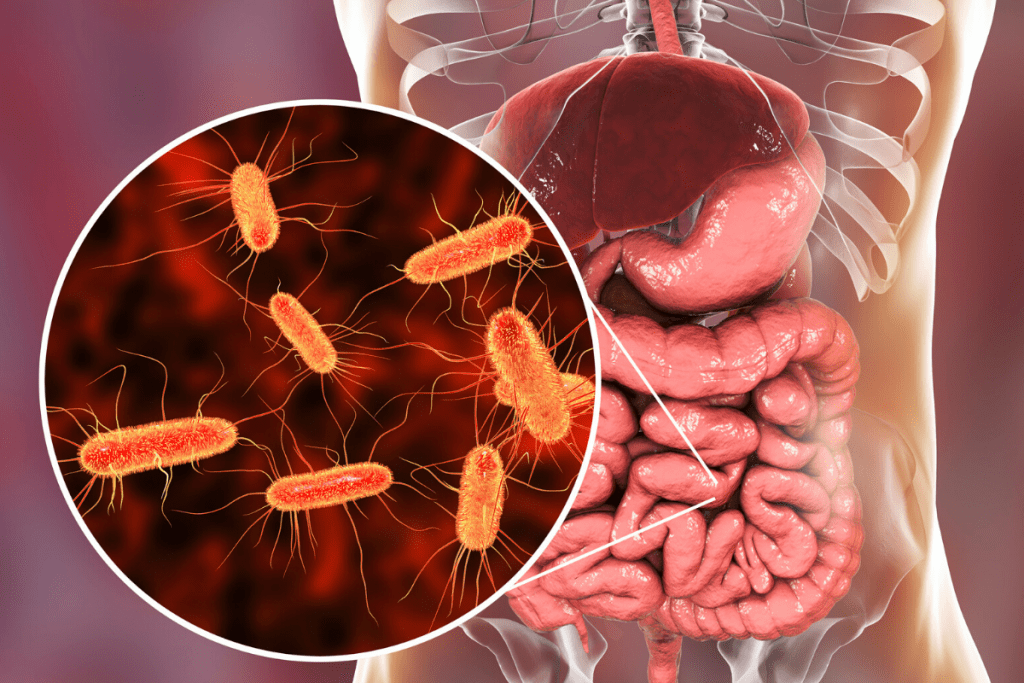
The food we eat has a significant role to play in health and well-being. A lot of these benefits can be linked back to the way in which food impacts and supports the gut microbiome and overall gut health. The diversity of plant foods, such as aiming for 30 plants per week, is an approach that can be used to optimise the diet to include a wide range of variety on a day-to-day basis.
What is the “30 Plants Per Week” Concept?

Aiming for 30 plants a week is a concept popularised by Dr Tim Spector. This is an approach that focuses on including a wide diversity of plant foods each and every week.
Prior to this, a common recommendation was to include 5 portions of fruit and vegetables per day. While this can be healthy, it does not focus on diversity/the range of fruits and vegetables included.
Aiming for 30 plant foods each week focuses on ensuring a wide range of diverse foods and reducing the change of simply eating the same 5 fruits and vegetables each day.
Why Aim for 30 Plants per Week?
Aiming for 30 plants per week is an important way to support the gut microbiome. An analogy that can often be helpful is that if we think about the gut microbiome as a building, we want to see all of the bricks in place to provide a strong and stable structure.
Since plant foods contain compounds and fibres that support the growth of beneficial gut bacteria, we can think of each plant food as ‘feeding’ a brick in the building.
Therefore, the more bricks we feed, the more we strengthen the building and the better it functions.
This can help regulate inflammation in the bowel as well as make it more resilient and less prone to infections or imbalances.
Health Benefits of diversifying your diet
A diverse diet supports a diverse gut microbiome which has been linked to improved gut health.
This can include factors such as:
- Better digestion
- A stronger immune system
- Enhanced mood
- Reduced risk of digestive issues (eg IBS or IBD)
As well as a more balanced and resilient gut microbiome, a wider range of plant foods also support health by providing a wider range of vitamins and minerals.
For example, if the same 10 plant foods were eaten each day, while they may provide vitamins and minerals to support health, a more diverse diet would provide a wider range of nutrients to optimise health.
It can also be considered that a more diverse diet can reduce the risk of food intolerances developing.
Gut microbiome health

A diverse range of dietary plant foods can support the gut microbiome by supporting the growth of beneficial bacteria.
These bacteria can support digestion as well regulate the health of the gut lining and support anti-inflammatory processes.
In turn, these beneficial organisms in the gut also produce compounds that can help to regulate the growth of less beneficial organisms. These less beneficial organisms can include opportunist fungal species such as candida.
So not only does a diverse diet support the growth of beneficial gut organisms, but it also prevents opportunist microorganisms from growing in the gut.
What Counts as a Plant Point?
When working towards including 30 different plant foods in the diet, can help to understand what a plant food is.
For the most part a simple definition, a plant food can be considered as something that grows from the ground or a tree. However, we can also consider seaweed and algae (eg Spirulina) to be plant foods also.
The categories of plant foods include:
- Vegetables
- Fruits
- Whole grains
- Legumes
- Nuts and seeds
- Herbs and spices
Vegetables
A wide range of vegetables can be considered to increase the diversity of plant foods in the diet. Soups and stews as well as diverse and colourful salads can be ways to easily increase plant diversity.
It’s also worth noting that certain vegetables release different nutrients as they cook. Therefore including raw and cooked vegetables can optimise further.
Vegetables include:
- Artichoke
- Asparagus
- Aubergine
- Beetroot
- Broccoli
- Brussels sprouts
- Cabbage
- Carrots
- Cauliflower
- Celeriac
- Celery
- Courgette
- Cucumber
- Endive
- Fennel
- Green beans
- Kale
- Kimchi
- Lettuce
- Mushrooms
- Okra
- Peppers
- Pumpkin
- Radicchio
- Radishes
Fruits
While a variety of fruits can depend on seasonality, supermarkets often have a similar selection of fruits all year round. This can limit the options available to us.
Was to work with his is to pick a different variety of fruit (e.g., a different type of apple) as well as considering shopping from green grocers or online delivery services who often have a wider range of options.
Fruits include:
- Apples
- Apricots
- Banana
- Blackberries
- Cranberries
- Grapefruit
- Grapes
- Goji berries
- Figs
- Kiwi
- Melon
- Orange
- Papaya
- Pineapple
- Pomegranate seeds
- Raspberries
- Strawberries
- Tangerines
Whole Grains
Whole grains can be included in the approach to increase plant diversity.
Where are processed grains such as white flour products (white bread, white pasta) removes the gut-friendly fibre, while grains have not been refined and contain the natural elements to support microbiome health.
These include:
- Amaranth Barley
- Buckwheat Millet
- Oats
- Quinoa
- Rice
- Rye
- Sorghum
- Teff
- Wheat
Rotating through these options or mixing them together can help add extra plant points.
Legumes and Beans
Legumes and beans contain high levels of prebiotic fibres which support the gut microbiome. These fibres are fermentable which act as an important energy source for beneficial microbes in the large intestine.
These are often a central ingredient in soups, stews and curries. It’s also possible to pre-cook these and add them to salads or turn them into dips or sauces.
These include:
- Red lentils
- Moong
- Yellow gram
- Chickpea
- Pigeon peas
- Red kidney beans
- Black-eyed peas
- Pinto beans
- Black beans
Nuts and Seeds
A wide variety of nuts and seeds are available and can be an easy way to support plant diversity. These can be added to breakfasts such as porridge, used as snacks and even toasted and added on top of salads for a few extra plant points at meal times.
Nuts and seeds include:
- Almonds
- Brazil nuts
- Cashews
- Chia seeds
- Coconut
- Flaxseed
- Hazelnuts
- Hemp seeds
- Macadamias
- Nut butter
- Peanuts
- Pecans
- Pine nuts
- Pistachios
- Pumpkin seeds
- Sesame seeds
- Sunflower seeds
- Walnuts
Herbs and Spices
Herbs and spices can add variety but can also provide a wider range of tastes and flavours. Working to include dried as well as fresh herbs and spices can further diversify the diet.
Many spices such as turmeric, also provide potent antioxidant properties which can support overall health and well-being.
These include:
- Basil
- Parsley
- Cilantro
- Cumin
- Coriander
- Cayenne
- Mint
- Rosemary
- Thyme
- Oregano
- Sage
- Chives
- Dill
- Paprika
- Tarragon
- Fennel
- Turmeric
- Sorrel
30 Plant Points Food Chart
Vegetables | Fruits | Whole Grains | Legumes | Nuts & Seeds | Herbs & Spices |
Artichoke Asparagus Aubergine Beetroot Broccoli Brussels sprouts Cabbage Carrots Cauliflower Celeriac | Apricots Banana Blackberries Cranberries Grapefruit Grapes | Amaranth Barley | Red lentils | Almonds Brazil nuts Cashews Chia seeds Coconut Flaxseed Hazelnuts Hemp seeds Macadamias | Basil |
Tips for Achieving 30 Plants a Week

When working to improve diversity, there can be small tweaks that can lead to big changes. This can be as simple as adding different fruits to breakfast porridge and adding some extra nuts and seeds on top.
There can also be a period of adjustment as new foods are explored and introduced will new recipes. This can take some extra time and meal planning in the short term. However, batching cooking and freezing some of these portions can save time further down the line.
So not only try new plant foods but also add more variety of the plants currently in the diet to soups, stews and salads.
There are several ways to work to track plant points. One helpful way is to keep a chart on the first with a range of plant foods. This can be particularly helpful and engaging with children.
Conclusion
Aiming for 30 different plant foods each week can often provide more diversity than 5 per day, as often we can be stuck in eating the same 5 each day.
Changing shopping patterns as well as tweaking recipes can help to improve diversity. Not only can this lead to more enjoyment from food but also improve gut health and overall well-being.
References
- Xiao C, Wang JT, Su C, Miao Z, Tang J, Ouyang Y, Yan Y, Jiang Z, Fu Y, Shuai M, Gou W, Xu F, Yu EY, Liang Y, Liang X, Tian Y, Wang J, Huang F, Zhang B, Wang H, Chen YM, Zheng JS. Associations of dietary diversity with the gut microbiome, fecal metabolites, and host metabolism: results from 2 prospective Chinese cohorts. Am J Clin Nutr. 2022 Oct 6;116(4):1049-1058. doi: 10.1093/ajcn/nqac178. PMID: 36100971; PMCID: PMC9535526.
- Verger EO, Le Port A, Borderon A, Bourbon G, Moursi M, Savy M, Mariotti F, Martin-Prevel Y. Dietary Diversity Indicators and Their Associations with Dietary Adequacy and Health Outcomes: A Systematic Scoping Review. Adv Nutr. 2021 Oct 1;12(5):1659-1672. doi: 10.1093/advances/nmab009. PMID: 33684194; PMCID: PMC8483968.
- Mozaffari H, Hosseini Z, Lafrenière J, Conklin AI. The role of dietary diversity in preventing metabolic-related outcomes: Findings from a systematic review. Obes Rev. 2021 Jun;22(6):e13174. doi: 10.1111/obr.13174. Epub 2021 Feb 21. PMID: 33615679.
- Staudacher HM, Ralph FSE, Irving PM, Whelan K, Lomer MCE. Nutrient Intake, Diet Quality, and Diet Diversity in Irritable Bowel Syndrome and the Impact of the Low FODMAP Diet. J Acad Nutr Diet. 2020 Apr;120(4):535-547. doi: 10.1016/j.jand.2019.01.017. Epub 2019 Apr 24. Erratum in: J Acad Nutr Diet. 2020 Dec;120(12):2098. doi: 10.1016/j.jand.2020.09.038. PMID: 31029650.






